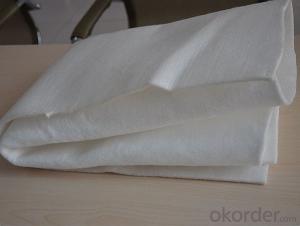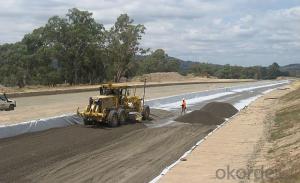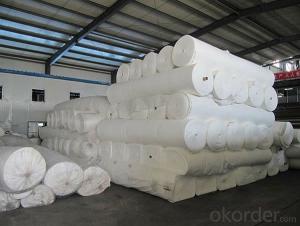Non-woven Geotextile with High Stabilization Compounding Silk
- Loading Port:
- China main port
- Payment Terms:
- TT OR LC
- Min Order Qty:
- 1000 m²
- Supply Capability:
- 10000000 m²/month
OKorder Service Pledge
OKorder Financial Service
You Might Also Like
Item specifice
Geotextile Fabrics
CNBM landscape fabrics are versatile and can be used for soil separation, reinforcement,
stabilization filtration, and weed restriction. There are many geotextiles and sizes to
choose from for a wide range of applications.
Woven (Stabilization and Soil Separation Fabrics)
Polypropylene slit-film geotextiles utilized in applications such as separation of
aggregate base materials and native soils in roadway construction, stabilization over soft
soils and separation between dissimilar soils.
Non-woven (Filtration and Drainage Fabrics)
Needlepunched polypropylene fiber geotextiles utilized in site drainage, blanket drains
and pipe joint wrapping and erosion control under rip rap.
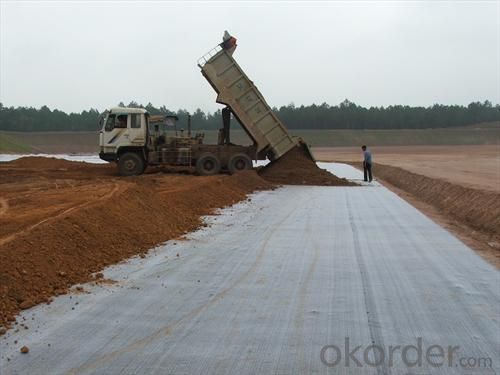
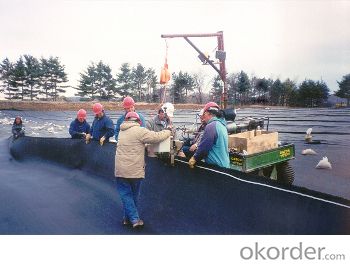
Our Service
Quality assurance
1.On a regular basis or as per your request,we entrust national testing agencies to conduct quality inspections
2. Strictly in accordance with the ISO9001-2008 international quality system standard,we monitor and manage the whole process throughout production,quality testing,and measurement to ensure product quality
3. For quality-related construction delay or substandard construction(except for damage or losses due to customer’s responsibility or irresistible natural disasters),we have refunding,replacement,and repair services.We will respond to customers’ feedbacks on quality issues within 24 hours.
After-sales service
1.In order to provide customers with comprehensive technical support,we will provide technical and other related information upon request in a timely manner.
2.In required,we will appoint specialized technicians to the construction site to give technical trainings to construction people,and offer technical guidance throughout the whole construction process.
3.For damage due to shipment and delivery,after we receive the complaint,we will check the issure through provided pictures and videos.If our responsibility is confirmed,we wil offer free replacement.
4.When the construction is completed,as your request,our technical staff may participate in the final acceptance.
FAQ:
Q: What kind of payments does jenor support?
A: T/T, L/C, Cash are accepted.
Q: Do you charge for the samples?
A: Accordeing to our company policy, the samples are free, we only charge the freight fee. And we will return the freight fee during the next order.
Q: Can you produce according to customers' design?
A: Sure, we are professional manufacturer, OEM and ODM are both welcome.
Q: Do you have other products?
A: Yes, please check the pictures:
Packaging & Shipping
Packing: PLASTIC FILM INSIDE, AND WOVEN BAG OUTSIDE
Shipping: About 15 days after receipt the deposit
geotextile fabric
permeability,filtration,easy for construction
ISO and CE certificate
Good quality and competitive price
- Q:What are the installation guidelines for geotextiles used in erosion control blankets?
- The installation guidelines for geotextiles used in erosion control blankets typically involve several steps. Firstly, the area where the blanket will be installed should be properly prepared by removing any vegetation or debris. The soil surface should be smooth and compacted. Next, the geotextile should be rolled out over the prepared area, ensuring it is properly aligned and overlaps any adjacent sections. It is important to secure the geotextile with stakes or pins to prevent it from shifting during installation. Once the geotextile is in place, it should be covered with an appropriate layer of soil or mulch to provide additional stability and protection. This layer should be evenly distributed and compacted to prevent erosion. Regular maintenance and inspection of the erosion control blanket and geotextile is also necessary to ensure their effectiveness. This may involve checking for any signs of damage, such as tears or rips, and repairing or replacing them as needed. Overall, following the manufacturer's guidelines and best practices for installation will help ensure the geotextiles used in erosion control blankets perform optimally and provide effective erosion control.
- Q:Whether the non-woven geotextile is required for inspection
- Check, you go to 4 square meters to bring it, do not take the head, the standard horizontal and vertical
- Q:Can geotextiles be used in road construction?
- Yes, geotextiles can be used in road construction. They are commonly used as a part of the road pavement system to enhance the performance and durability of the roads. Geotextiles provide reinforcement, separation, and filtration functions, helping to prevent the mixing of different soil layers, improving load distribution, and reducing the potential for pavement damage.
- Q:Whether the geotextile filter layer includes a plastic mesh
- Hello, geotextile can be used as a separate filter and grid sand with as a filter layer, Huazhi geotextile material manufacturers for you to answer
- Q:What is geotextile, what role
- Geotextile is a new type of building materials, raw materials are polyester, acrylic, nylon and other polymer polymer synthetic fiber. In accordance with the manufacturing method is divided into: there are two types of geotextile and non-woven geotextile. Geotextile with anti-seepage, anti-filtration, drainage, isolation, reinforcement, protection, sealing and other functions, it with the conventional masonry and concrete material seepage effect compared to a low investment, simple construction process, short duration Infiltration effect is good, the channel effective use of high coefficient. Water conservancy engineering dams and slope protection filter, channel isolation, seepage control; road, railway, airport runway foundation isolation, filter, drainage, slope, retaining wall and road reinforcement, drainage; , Geotextile has been widely used in the field of infrastructure construction, and has been gradually applied in the field of infrastructure construction, and the use of geotextile In a wider area.
- Q:Fish pond geotextile use method
- HDPE geomembrane can be used to do impermeable, I professional production
- Q:Are geotextiles suitable for use in waste containment systems?
- Yes, geotextiles are suitable for use in waste containment systems. They provide effective filtration, separation, and reinforcement properties, helping to prevent the migration of fine particles and contaminants into the surrounding environment. Geotextiles also enhance the stability and durability of waste containment systems, making them an ideal choice for various waste management applications.
- Q:Do you need to suture the lower geotextile of composite geomembrane?
- Under normal circumstances without suture (stretch, overlap to a piece like), just the geomembrane welding, the top layer of geotextile with a hand sewing machine sewing can be geotextile as a protective layer of geomembrane, to protect the impermeable layer In order to reduce the UV radiation, increase the anti-aging performance, it is best to use the laying method of laying.In the construction, the first use of smaller diameter sand or clay to find the base surface, and then laying, Too tight, buried at both ends of the soil part of the corrugated, and finally in the shop on the two cloth a film with fine sand or clay shop layer of 10cm over the layer. Puzzle 20-30cm stone (or concrete prefabricated block) For the protection of the layer.When the construction, should try to avoid the stone directly hit on the best side of the film side of the protective layer of the construction of the two cloth a film and the surrounding structure should be connected with expansion bolts and steel plate pressure bar anchor, The connection part to brush the emulsion asphalt (2mm thick) bonding, to prevent the occurrence of leakage. Construction joint processing is a key process, a direct impact on seepage effect. General seam way: ① lap: lap width Should be greater than 15cm; ② heat welding: suitable for slightly thick geomembrane substrate, weld lap width of not less than 5C M
- Q:What is the place of attention for the laying of geotextiles?
- (1) the use of the use of buried type: cover the thickness should not be less than 30cm (2) refurbishment system should be: cushion, impermeable layer, transition layer, protective layer composition. (3) soil to be solid, to avoid uneven subsidence, cracks, anti-seepage within the turf, root to clear. And the surface of the membrane with a small particle size of sand or clay as a protective layer. (4) laying the geomembrane do not pull too tight, both ends of the soil into the corrugated part of the soil is better, especially with the rigid material anchoring, should leave a certain amount of expansion and contraction. (5) construction, should avoid stones,
- Q:How do geotextiles help in preventing the loss of fine particles in filter layers?
- Geotextiles help in preventing the loss of fine particles in filter layers by acting as a barrier that allows water to pass through while retaining the fine particles. They provide stability and support to the filter layer, preventing erosion and displacement of particles due to water flow. Additionally, geotextiles enhance filtration efficiency by preventing clogging of the filter layer, allowing it to function optimally and retain the necessary fines.
1. Manufacturer Overview |
|
|---|---|
| Location | |
| Year Established | |
| Annual Output Value | |
| Main Markets | |
| Company Certifications | |
2. Manufacturer Certificates |
|
|---|---|
| a) Certification Name | |
| Range | |
| Reference | |
| Validity Period | |
3. Manufacturer Capability |
|
|---|---|
| a)Trade Capacity | |
| Nearest Port | |
| Export Percentage | |
| No.of Employees in Trade Department | |
| Language Spoken: | |
| b)Factory Information | |
| Factory Size: | |
| No. of Production Lines | |
| Contract Manufacturing | |
| Product Price Range | |
Send your message to us
Non-woven Geotextile with High Stabilization Compounding Silk
- Loading Port:
- China main port
- Payment Terms:
- TT OR LC
- Min Order Qty:
- 1000 m²
- Supply Capability:
- 10000000 m²/month
OKorder Service Pledge
OKorder Financial Service
Similar products
New products
Hot products
Related keywords


